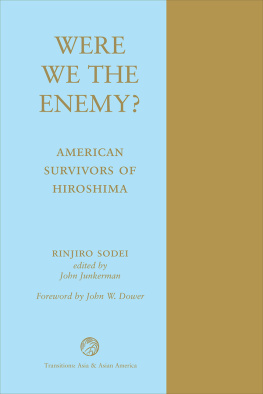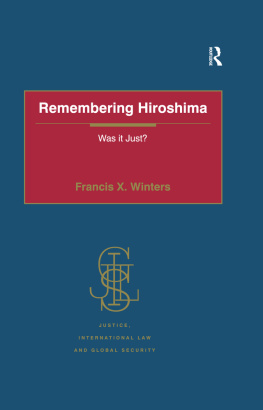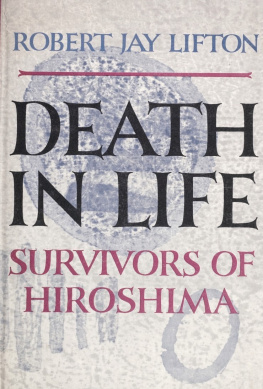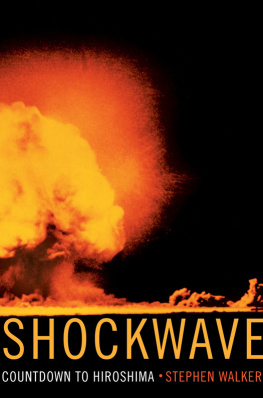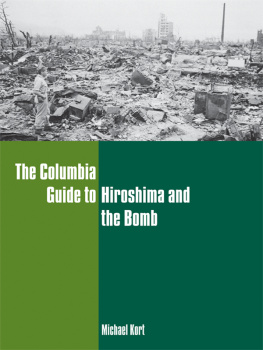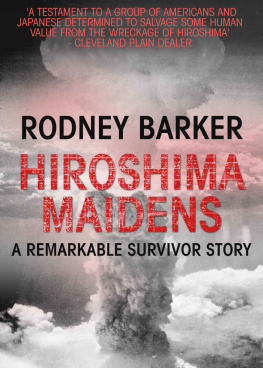Were We the Enemy?
Transitions: Asia and Asian America
Series Editor, Mark Selden
Were We the Enemy? American Survivors of Hiroshima,
Rinjiro Sodei
North Koreans in Japan: Language, Ideology, and Identity,
Sonia Ryang
Proletarian Power: Shanghai in the Cultural Revolution,
Elizabeth J. Perry and Li Xun
City-States in the Global Economy: Industrial Restructuring in Hong Kong and Singapore,
Stephen Wing-Kai Chiu, Kong-Chong Ho, and Tai-lok Lui
The Taiwan-China Connection: Democracy and Development Across the Taiwan Straits,
Tse-Kang Leng
Trade and Transformation in Korea, 1876-1945,
Dennis L. McNamara
Hidden Horrors: Japanese War Crimes in World War II,
Yuki Tanaka
Encountering Macau: A Portuguese City-State on the Periphery of China,
1557-1999, Geoffrey C. Gunn
How the Tarmers Changed China: Power of the People,
Kate Xiao Zhou
Prom Plan to Market: The Economic Transition in Vietnam,
Adam Fforde and Stefan de Vylder
A New Woman of Japan: A Political History ofKatb Shidzue,
Helen M. Hopper
Japanese Colonialism in Taiwan: Land Tenure, Development, and Dependency,
1895-1945, Chih-ming Ka
Vietnams Rural Transformation,
edited by Benedict J. Tria Kerkvliet and Doug J. Porter
The Origins of the Great Leap Torward: The Case of One Chinese Province,
Jean-Luc Domenach
The Politics of Democratization: Generalizing East Asian Experiences,
edited by Edward Friedman
Our Land Was a Torest: An Ainu Memoir,
Kayano Shigeru
Transitions: Asia and Asian America
First published 1998 by Westview Press
Published 2018 by Routledge
711 Third Avenue, New York, NY 10017, USA
2 Park Square, Milton Park, Abingdon, Oxon OX14 4RN
Routledge is an imprint of the Taylor & Francis Group, an informa business
Copyright 1998 Taylor & Francis
All rights reserved. No part of this book may be reprinted or reproduced or utilised in any form or by any electronic, mechanical, or other means, now known or hereafter invented, including photocopying and recording, or in any information storage or retrieval system, without permission in writing from the publishers.
Notice:
Product or corporate names may be trademarks or registered trademarks, and are used only for identification and explanation without intent to infringe.
Library of Congress Cataloging-in-Publication Data
Sodei, Rinjiro, 1932-
[Watakushitachi wa teki datta no ka. English]
Were we the enemy? : American survivors of Hiroshima / Rinjiro Sodei; edited by John Junkerman.
p. cm. (TransitionsAsia and Asian America; 204)
ISBN 0-8133-2960-4 (hc)
1. Hiroshima-shi (Japan)HistoryBombardment, 1945Personal narratives. 2. World War, 1939-1945Japanese Americans. 3. AmericansJapan. 4. JapaneseUnited States. I. Junkerman, John. II. Title. III. Series. D767.25.H6S6213 1998
940.54'26dc21
97-45583
CIP
ISBN 13: 978-0-8133-3750-0 (pbk)
It is always sobering to learn how long it takes to see things clearly. Even cataclysmic events like the atomic bombings of Hiroshima and Nagasaki, which almost mesmerized the entire world when they took place over a half century ago, have revealed their secrets, their full dimensions, only slowly.
Take, for instance, what might seem to be a straightforward issue: the number of men, women, and children killed by the bombs. Early estimates by the U.S. government put these in the range of between 70,000 and 80,000 killed in Hiroshima and 35,000 in Nagasaki, and low figures of this order have survived in some sources to the present day. In fact, as became clear by the 1970s, the most credible calculations place fatalities at roughly double those numbers in each city. Around 210,000 individuals probably were killed by the two bombs (140,000 in Hiroshima and 70,000 in Nagasaki), most of these deaths occurring immediately or in the months that followed. To the present day, small numbers die each year of bomb-related effects; and to the present day, there are still no clearly disaggregated, cumulative, official figures on this seemingly most fundamental of questions.
Or take the question of what it is that defines a hibakusha, or atomic-bomb victim. In Japan, formal definition did not come until 1957, when the government belatedly agreed to provide special free medical services to survivors. Under Japanese law, several categories of individuals qualify for such care: persons who were within four kilometers of the hypocenters of the bombs; those who entered the stricken cities within three days, and came within two kilometers of ground zero; and those who were in utero when their mothers became hibakusha. Because of the uncertain genetic effects of the nuclear irradiation, the Japanese government also extends medical care to children subsequently born to survivors.
With rare exceptions, persons who were within one kilometer of the hypocenters were killed instantly by some combination of blast, heat, fire, and radiation. To the Japanese and non-Japanese researchers who have studied the long-term medical effects of the bombs, by far the most vulnerable group of survivors was within approximately two kilometers of ground zero at the time of impact. How much radiation each individual may have been exposed to can only be estimated by a careful radiation dosimetry that takes into account the total amount of radiation released by each bomb, plus exactly where each survivor was, and how exposed or protected (by walls, terrain, or the like) he or she may have been. Before political pressure led the government to adopt broader criteria, Japanese physicians also focused on those who had been within this two-thousand meter radius when the bombs exploded.
As the imprecision of the concept of survivor suggests, it has been difficult to grasp the full dimensions of the atomic-bomb experience because that experience is still with us, still revealing new mutant faces. To speak of the effects of the bombs is to speak not merely of the early, gruesome mass deaths, but of pathologies that have exposed themselves only piecemealand with decidedly different impacts and meanings depending on whether it be to scientists, to detached laymen, or to the survivors themselves. Almost immediately, published photographs made the general public familiar with the hard, disfiguring keloid scars suffered by many burn victims. Soon afterwards, despite U.S. government attempts to repress such reportage, the horrendous atomic-bomb disease that cut through seemingly healthy survivors like a bloody scythe became well known: hair falling out in clumps, purple splotches on the skin, bloody vomit and diarrhea, thirst, fever, death.
This was but the start of the macabre process of learning what August 6 and August 9 had wrought. Within a few years, it became clear that the bombs had reached into the womb. Stillbirths and neonatal deaths were abnormally high among births to women who had been pregnant when exposed to the bombs. Among the surviving children, stunted growth, including small head size and a high incidence of severe mental retardation, was common. Beginning in 1947, researchers associated with the U.S.-sponsored Atomic Bomb Casualty Commission attempted to examine every newborn child in Hiroshima and Nagasaki (they succeeded in ninety-five percent of all households)arriving in still shattered neighborhoods with great solemnity in their official vehicles, an occasion for all to behold. Where the child was stillborn or soon died, autopsies were requestedan unfamiliar practice in Japan, bordering on desecration (a majority of bereaved families nonetheless complied). Regular examinations of the children of survivors were carried out over the years that followed. Imagine being the parent in such a household, or the child, or a prospective spouse.

